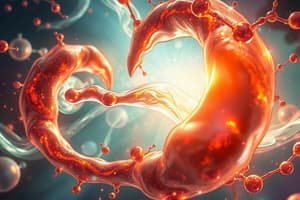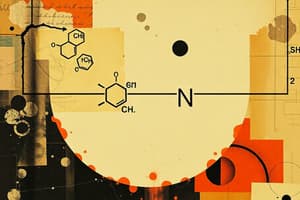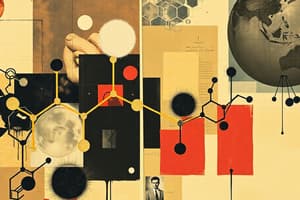Podcast
Questions and Answers
Which of the following best describes an Sn2 reaction mechanism?
Which of the following best describes an Sn2 reaction mechanism?
- Requires a strong nucleophile and a protic solvent
- Two-step process involving a carbocation intermediate
- Involves rearrangement of carbocation for product formation
- One-step process with a simultaneous bond breaking and forming (correct)
In an Sn1 mechanism, the rate of the reaction depends on the concentration of the nucleophile.
In an Sn1 mechanism, the rate of the reaction depends on the concentration of the nucleophile.
False (B)
What type of alkyl halide will generally undergo an Sn2 reaction most readily?
What type of alkyl halide will generally undergo an Sn2 reaction most readily?
primary alkyl halide
The _______ effect refers to the preference for a leaving group to be situated opposite to any nucleophile or leaving proton in an E2 elimination.
The _______ effect refers to the preference for a leaving group to be situated opposite to any nucleophile or leaving proton in an E2 elimination.
Match the type of solvent with its classification:
Match the type of solvent with its classification:
What is a characteristic of a tertiary alkyl halide in an Sn1 reaction?
What is a characteristic of a tertiary alkyl halide in an Sn1 reaction?
The major product of an E2 reaction typically follows _________'s rule, meaning the most stable alkene is favored.
The major product of an E2 reaction typically follows _________'s rule, meaning the most stable alkene is favored.
In the presence of a strong nucleophile, Sn1 reactions are always favored over Sn2 reactions.
In the presence of a strong nucleophile, Sn1 reactions are always favored over Sn2 reactions.
Flashcards
Sn2 Reaction
Sn2 Reaction
A nucleophilic substitution reaction where the nucleophile attacks the electrophilic carbon from the backside, leading to inversion of configuration. It proceeds in one step, with the nucleophile and leaving group interacting simultaneously.
Walden Inversion
Walden Inversion
The change in stereochemistry observed in an Sn2 reaction, where the configuration at the reaction center is inverted. The nucleophile attacks from the opposite side of the leaving group, causing the groups attached to the carbon to flip.
Carbocation Rearrangement
Carbocation Rearrangement
A process where a carbocation rearranges its structure to become more stable by shifting a hydrogen or an alkyl group from an adjacent carbon to the carbocation center. This results in a more substituted (and stable) carbocation.
Nucleophilicity
Nucleophilicity
Signup and view all the flashcards
Protic Solvent
Protic Solvent
Signup and view all the flashcards
Leaving Group
Leaving Group
Signup and view all the flashcards
Zaitsev's Rule
Zaitsev's Rule
Signup and view all the flashcards
E2 Reaction
E2 Reaction
Signup and view all the flashcards
Study Notes
SN2 Reaction
- Reactants/Reagents: Alkyl halide and nucleophile
- Products: Substitution product (involving inversion of configuration)
- Mechanism (One-Step): Nucleophile directly attacks the carbon bonded to the leaving group, forming a transition state with a pentavalent carbon. The leaving group departs in a concerted step.
- Walden Inversion: Nucleophilic attack leads to a change in stereochemistry at the reaction site.
SN1 Reaction
- Reactants/Reagents: Alkyl halide, solvent (polar protic preferred)
- Products: Alcohol, ether (depending on the nucleophile) - Consider carbocation rearrangement.
- Mechanism: Leaving group departs forming a carbocation intermediate. The nucleophile attacks the carbocation, forming the product. Rearrangements can occur if more stable carbocations are possible.
- Carbocation Rearrangement (SN1): Arrows show the movement of electrons during a rearrangement to form a more stable carbocation.
- Examples: Hydride shifts, methyl shifts (depending on the carbon skeleton).
Nucleophilicity Trends
- Nucleophilicity is the ability of a reactant to donate an electron pair.
- Factors affecting nucleophilicity: electronegativity, steric hindrance, charge, solvent effects (intermolecular forces).
- Protic vs. Aprotic Solvents: Solvent interactions with nucleophiles affect nucleophile strength.
Basicity vs. Nucleophilicity
- Basicity relates to the ability of a compound to accept a proton (electron pair acceptor).
- Nucleophilicity is the ability to donate an electron pair.
- They are not always correlated: a strong base is not always a strong nucleophile. (e.g., hydroxides are stronger bases but weaker nucleophiles in protic solvents due to solvation)
Solvent Effects on Nucleophilicity
- Polar protic solvents can hinder nucleophilicity by forming strong hydrogen bonds with nucleophile.
- Polar aprotic solvents enhance nucleophilicity by reducing the solvation of nucleophiles.
Reaction Classification
- Alkyl Halide: Identify as primary, secondary, or tertiary based on the number of alkyl groups directly attached to the reaction center.
- Solvent: Classify as polar protic, polar aprotic, protic, or nonpolar.
Reaction Rate Influences (SN1, SN2, E1, E2)
- Leaving Group: Better leaving groups promote faster reactions.
- Substrate Structure: SN2 favored by primary, SN1 favored by tertiary.
- Nucleophile: Stronger nucleophiles lead to faster SN2 reactions.
- Solvent: Polar protic favors SN1, polar aprotic favors SN2.
Transition State/Intermediate Stability & Reaction Rate
- Stable transition states/intermediates lead to faster reaction rates.
- Reaction coordinate diagrams illustrate the energy profile for the reaction.
Stereoelectronic Effects in E2 Reactions
- Antiperiplanar: Leaving group and proton undergoing elimination must be antiperiplanar to minimize steric hindrance, (E2 only).
E2 Reactions of Cyclohexyl Halides
- Major Products: Depends on substituents on the cyclohexane ring. More readily available, less hindered periplanar positions will prevail.
- Relative Rates: Degree of substitution at the eliminated carbon matters
Alkene Stability
- Substitution: More substituted alkenes (e.g., trisubstituted, tetrasubstituted) are more stable than monosubstituted.
- Steric Strain: Structure of the compound affect stability
Non-Zaitsev/Hoffmann Products in E2 Reactions
- Non-Zaitsev products occur when the more substituted alkene is not favored due to steric or conformational constraints.
Zaitsev's Rule & E1 Reactions
- Zaitsev's Rule: The major product of an E1 reaction will be the more substituted alkene.
Stereochemistry in SN1/SN2/E1/E2 Reactions
- Chiral/achiral starting material will result in chiral/achiral products.
- Stereochemistry is related to the reaction pathway.
SN1/SN2/E1/E2 Competing Reactions
- Factors like structure, nucleophile, and solvent determine which reaction pathway is favored.
Predicting Reaction Pathways & Products (multiple reactions conditions)
- Analyze structural and electronic factors to choose the favored pathway in complex reaction scenarios.
Studying That Suits You
Use AI to generate personalized quizzes and flashcards to suit your learning preferences.




